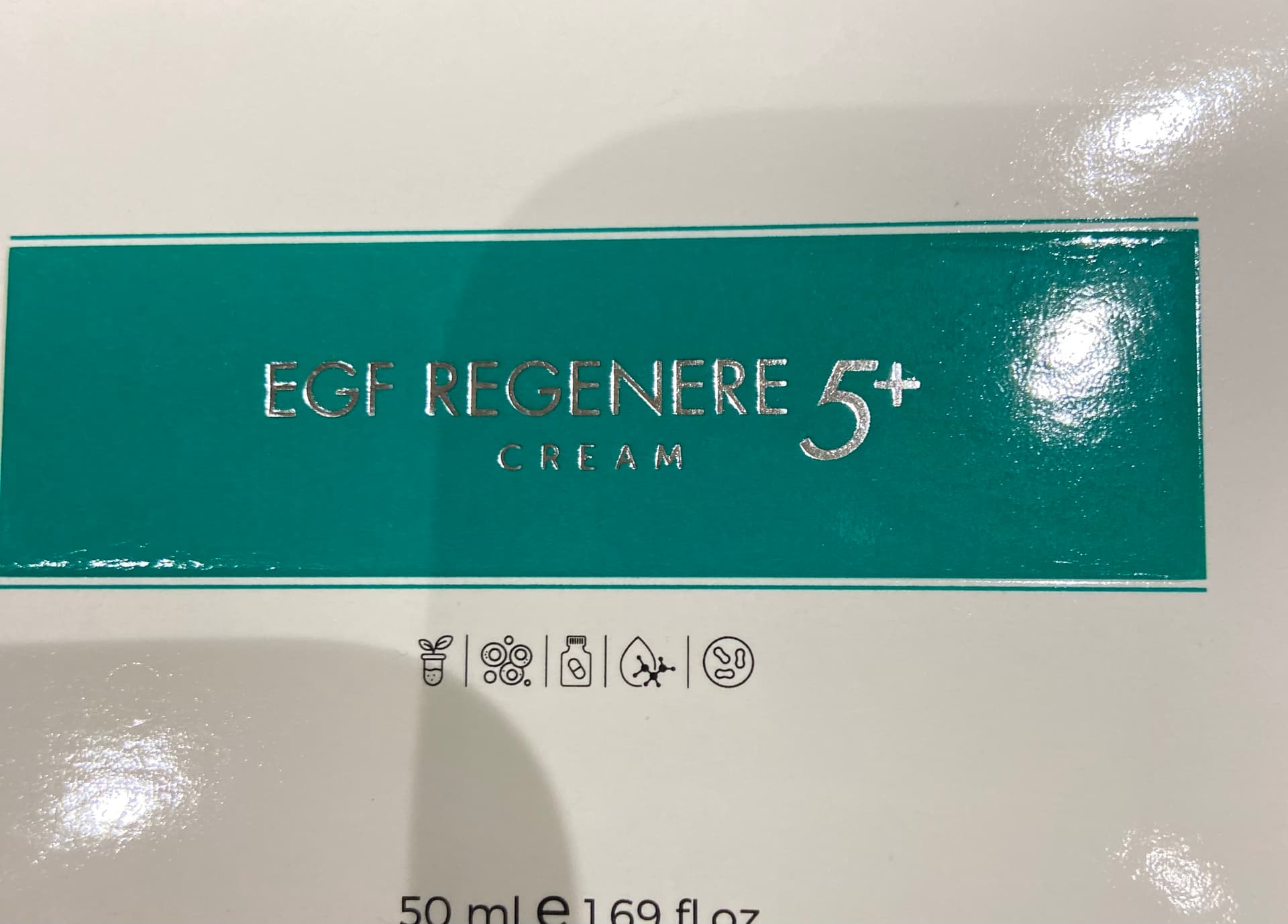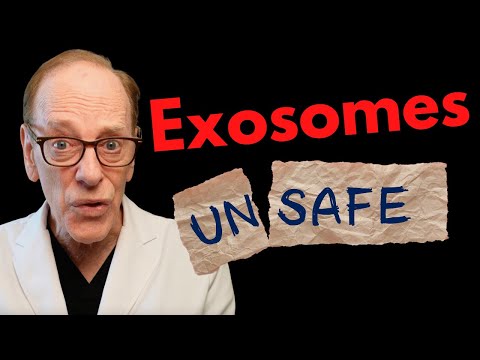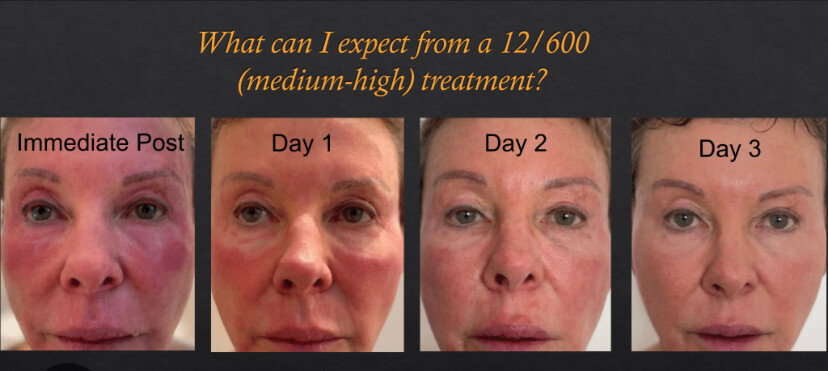After you explained it in great detail I understood that it’s definitely not for me. Please share how it heals and how quickly.
I don’t think it is difficult to administer the machine and that something should go wrong as long as the machine works well.
I think it is not impossible to do it yourself but it will take discipline: ( am not as experienced as Medaura ![]() )
)
Firstly, putting anaesthetic crème precisely around the eye area ( but not in the eye) and covering with cling film is not that easy, but one could do one side at the time. ( Or try without anaesthetic)
Besides anaesthetics, the eye area is treated partly with eye closed (eyelid ) and partly open (when treated underneath) and she did manage to do it very close to the eye ( although my eye got very watery keeping the eye open), so that may need some practice (my reflex would probably be to close my eyes). It is not harmful for the eyes though ( they actually treat dry eye with the machine too).
The most difficult for me would be doing it in my neck area as it was painful WITH anaesthesia ( and I think I cope fairly well with pain).
It doesn’t seem very difficult though so with help of someone it should be easier.
It would take much longer if I would do it myself for sure ( this morning was 1,5 hours in the end with the anaesthetic crème that had to Work 20 minutes). While she was treating my neck I honestly thought I would not be able to do it myself but now that the day has passed and the cardboard feeling and the redness is getting somewhat less am not sure yet.
I am sure Medaura would be perfectly capable ![]()
Great in depth overview! My own pain threshold is much lower when someone else is doing something to me vs when I self administer—not sure how or why it works that way, perhaps because I feel in control or know to anticipate the discomfort down to the last millisecond.
Let us know what results you see in the next week or so! I’m excited for you.
I tried to find the cream online but seems not available for non-pros ; so i wonder also what cream you would use afterwards - not sure how important that is either ( the other tixel places I checked out didn’t mention anything about cream to apply afterwards)
the serum I got to apply the first hours I don’t even know what that was but it relieved
I don’t know anything about that cream specifically. I think the idea is that the tixel treatment will make skin temporarily capable of absorbing more topically so immediately post treatment would be a great time to apply anything fancy.
Considering the high temperature ( 400 degrees C ) of the tip in contact with face and neck, maybe immediately after it is important to use sth specific ? Or maybe simple pharmaceutical cream against burning wounds would do ? (as the look and feel was exactly that, as if 100 degree C boiling water got poured over my face - it’s slightly better now )
On the exosomes that Bryan Johnson uses : this warning from Doctor on YouTube:
Day of treatment : face looks like extremely (sun) burnt so while it’s true you can work, do it from home
Day 2: after sleep it looked much better; you can wash your face and put on make up. My eye area looks a bit swollen ( was informed it could be) but being swollen, all the wrinkles are gone so it was nice to see me without wrinkles for once ![]() .
.
Fun fact: my iPhone didn’t recognise my face without all those wrinkles and had to look up my bank pass code ![]()
Day 3:
Looking fine : a bit swollen /plump but I don’t mind as it takes away wrinkles and a few little marks but skin colour looks normal and also neck (although she told me my neck would take longer). With make up no one would notice anything today. My iPhone recognised my face again:)
The below pictures are from the Tixel website ( it’s not me): my first day my face was like the women in the picture, only it was entirely red - she has less red spots: i understand that this might be as I was treated on a high - not medium - setting) ; her third day is similar to my second and third day only am a bit more swollen ( with a pleasant side effect of having a more plump face, with much less wrinkle ![]() )
)
Day 5
Had an appointment at dermatologist today and she noticed immediately that I had done sth in my face, despite my make up (I assume she noticed the grid pattern that are still visible in the area under my eyes where the bone is- but she has a trained eye I guess; she doesn’t do tixel)
Day 6
Skin peeling a bit and the grid seems only still there on the right side under my eye (this may be a more sensitive area re the comment someone DIY posted on Reddit and was mentioned earlier in this thread). Skin still definitely feels as tight although the plumpness has gone.
Day 8: “grid “ marks practically gone; skin feels tight ; visible results so far ( but one would only see final result in 4 weeks or so ) are subtle but they are there.
Day 10: all grid marks disappeared ; skin is a bit more sensitive and drier as usual still- face feels very thigh although visible results are subtile. I plan to have another treatment or get my hand on machine myself , found great offer of 1600 USD all (shipping - albeit slow - and duties) included.
Please do! What parts of your body would you use this on? I think Brian Johnson does it all over his body (please correct me if I’m wrong on this).
At a price of only $1600, this would seem to be a very good financial investment if it works well, and you use it consistently over time.
@RapAdmin, as far as I understand, Tixel is primarily meant to be used for the face, neck, and décolleté + problem areas at body. Treating the face only will require 300-500 pulses, and the aforementioned areas together will need about 1000 pulses. Handling the entire body with Tixel would be challenging, and I have not seen any reports or studies on whole body treatments. The original Tixel device has two handles: one for the face and one dedicated to the periorbital area (smaller surface). The OEM version has one or two handles; the second option includes an additional handle for the body, which costs an extra $400-500 (I have decided for one handle version mainly because of price). As far as I understand, the body handle is meant to be used mainly for problem areas like scars…
Economics of the machine: One original handle can handle 500,000 pulses, but everything above 25,000 should be acquired from the producer. The OEM handle has a limit of 50,000 pulses. So, in fact, you are purchasing 50-100+ Tixel procedures with the OEM machine, which is still a good choice, considering that a single procedure costs around $400-500 at a cosmetic salon.
There appear to be slightly differing opinions on that…
This therapy is ideal for the delicate skin on the eyes, face, neck, chest, and hands.
Source: https://www.bellasanteclinic.com/tixel
Tixel is suitable for treating fine lines, wrinkles, sun damage, age spots, active acne, acne scars, pore size, lip lines, forehead lines, crepey skin on the eyelids, crow’s feet and neck folds among others. Body parts such as abdomen, knees and arms also get great results
Source: Med Spa - Tixel Skin Resurfacing – Estetica Spa
Seems like it could be used anywhere you want to tighten skin or improve skin health or “quality”.
This seems like something that a few friends could get together to purchase and then pass the device around between them, perhaps every month.
At $1600 to $2000 per device it would only be approximately, $500 to $700 per person.
Talk to your friends… And report back your results…
Thanks so much for sharing : I pulled the trigger on mine as well ( from Alibaba ) but to reduce costs I asked oversea shipping so will only arrive end of June or beginning July : since am away travelling for the moment I will look further into it again the next weeks but very much looking forward to your updates and will obviously do the same . I have another appointment when am back with the doctor who did the first treatment on me to see results after 8 weeks ( with professional fotos, my cell phone pictures are not clear enough ) but I can see improvements myself already (on one side of my mouth the lines practically seem to have disappeared when I look in the mirror ; on the other side - with more lines-, result is less spectacular/ visible). But curious to see the doctor’s precise pictures in a couple of weeks.
Great, look forward to your experience! I will experiment with pushing the neocollagenesis from inside and outside on a certain day: Tixel procedure, + activate MTOR before the procedure to push the building of new collagen (Efficient Combination of Longevity Strategies - #32 by SilentWatcher) (but no workout after tixel), + support the neocollagenesis with supplementation of collagen peptides / hyaluron / ceramides and apply mesotherapy complex on open channels → having inside/outside triggers (holistic approach). Will share experience.
I still have not received my machine but went today to get some professional “ after” pictures taken and the difference with the “ before” pictures was visible ( and should still improve I was told in the next 2 months).
Results are not dramatic but good enough to wanting to repeat: best visible results are around eyes and neck wrinkles ; but overall, all wrinkles, pores and skin quality improved. unfortunately the quality of my mobile pictures diminished the visibility of the results so I d rather not attach them
( still if someone wants to see them just ask and I can send them privately).
Are you just seeing reduction in wrinkles or have you noticed any skin tightening?
I particularly noticed constant skin tightening in the weeks afterwards ( as if I had constantly a mask on that tightened the skin) am not sure if I got used to it and that it is still there , or whether it decreased . From what I was told and read it is probably still there but one gets used to it ?
Anyway am pleased with the results and look forward to seeing results after a next session ( just hope I will be able to do it on myself without accidents ![]()
![]() )
)
Yes. Always hard to tell I think. Good luck. I’ve been planning on doing it, but have a have 2 and a half hour drive to find a clinic that doesn’t charge an arm and an exorbitant amount.
Recent studies on Tixel use for skin improvement:
The Efficacy of Thermal Mechanical Fractional Injury System for Facial Rejuvenation: Subjective, Objective and Image Analysis Study
J Cosmet Dermatol. 2025 Feb;24(2):e70063. doi: 10.1111/jocd.70063. (Open Access)
Background: Facial aging is the result of a number of factors, including the resorption of skeletal tissue, the atrophy of fat pads, and the laxity of connective tissue. These factors contribute to a reduction in facial volume and the development of skin changes. Thermal mechanical fractional injury (TMFI) represents a minimally invasive solution, stimulating collagen production and enhancing the delivery of topical formulations via epidermal microcraters.
Aim: This study seeks to evaluate the effects of TMFI on skin quality and introduce quantifiable methods to assess improvements.
Patients and methods: Adult patients seeking facial rejuvenation underwent three TMFI sessions, with a one-month interval between each session. The assessment of skin quality was conducted using the Scientific Assessment Scale of Skin Quality (SASSQ), which was completed by blinded experts. Patient satisfaction was evaluated using the FACEQ scale. Additionally, objective texture analysis was performed using the MAZDA program, which quantified surface irregularities.
Results: The objective assessments demonstrated statistically significant improvements in the following parameters: roughness, wrinkles, pore size, elasticity, pigmentation, and erythema (p < 0.001). The FACE-Q results demonstrated high patient satisfaction, with a response rate of 68.4%. The MAZDA analysis confirmed significant texture improvements across most facial zones, with the exception of the medial forehead.
Conclusions: The findings of this study indicate that TMFI is an effective intervention for improving skin quality in a diverse range of patients. This study contributes to the existing literature on TMFI, which supports its use as a valuable tool in the field of skin rejuvenation.
Clinical Efficacy and Safety of a Thermomechanical Fractional Injury Device for Neck Rejuvenation
Abstract
Background: Neck rejuvenation has consistently become a popular cosmetic procedure. While various treatment modalities have been used, a novel fractional thermomechanical skin rejuvenation system was recently developed to create dermal coagulation through direct heat transfer with subsequent neocollagenesis.
Objective: A prospective clinical trial evaluated the efficacy and safety of a thermomechanical fractional injury device (Tixel 2, Novoxel, Netanya, Israel) for neck rhytides.
Materials and methods: Subjects with moderate to severe neck rhytides were enrolled for 4 monthly treatments.
Results: Twenty-six subjects were enrolled and completed all study visits. The mean age was 58.4 years, and 100.0% were women. Fitzpatrick skin types I to IV were included. For Fitzpatrick Wrinkle Classification System (FWCS), the mean baseline score was 6.3. As per investigator, there was a mean 1.5-grade improvement in FWCS at 1-month follow-up ( p < .00001) and 1.4-grade improvement in FWCS at 3-month follow-up ( p < .00001). For physician Global Aesthetic Improvement Scale, all subjects (100%) had improvement at both 1- and 3-month follow-up visits. There were no severe adverse events, and subjects experienced minimal pain.
Conclusion: A novel thermomechanical fractional injury device is effective and safe for the treatment of neck rhytides.
Comprehensive Review of Thermomechanical Fractional Injury Device: Applications in Medical and Cosmetic Dermatology
Objective: Our aim was to review the current and emerging dermatological applications of the novel thermomechanical fractional injury (TMFI) device, Tixel® (Novoxel, Netanya, Israel).
Methods: A systematic review of PubMed using the search terms of “Tixel”, “thermomechanical fractional”, [“thermomechanical ablation” and “skin”], and [“thermomechanical ablation” and “dermatology”].
Results: Thirty-six articles matched our inquiry. Fifteen articles did not meet inclusion criteria. Of the remaining 21 articles, eight were related to device-assisted drug delivery, seven related to photoaging, and seven related to scientific/ preclinical exploration. Preclinical studies have shown ablative and non-ablative microchannel formation similar to that of CO₂ laser but without charring, with clinical studies demonstrating efficacy for a wide range of applications including rhytides, hypertrophic scarring, infantile hemangiomas, and acne/rosacea. The treatment is well tolerated with minimal discomfort and downtime, showing promise for pain-averse and pediatric populations. Few adverse events have been reported, with a high degree of safety demonstrated in all Fitzpatrick types.
Limitations: Heterogeneous result reporting among studies. Limited number of randomized controlled trials.
Conclusion: Tixel® is an emerging TMFI device with a wide range of current and potential applications, including device-assisted drug delivery and treatment of rhytides, photoaging, and scars among other conditions. The device has both ablative and non-ablative settings and has been safely used in all Fitzpatrick skin types. Larger and randomized controlled trials are needed to compare this device to current standard of care treatments.
and
Retrospective study on the safety and tolerability of clinical treatments with a novel Thermomechanical Ablation device on 150 patients
Introduction: There are currently not many publications on the safety of thermomechanical ablation (TMA) devices, and those that are published only have small numbers of subjects. This treatment is gaining popularity in Europe and Asia, and thus there is a need to look at the safety of this treatment.
Objective: The purpose of this retrospective study was to evaluate the safety of the clinical use of the novel TMA system (Tixel, Novoxel, Israel) for facial rejuvenation and treatment of acne scars.
Methods: We did a retrospective review of our first 150 patients who were treated with the TMA device.
Results: One hundred and fifty consecutive patients aged 20 years to 82 years with Fitzpatrick skin types I to V treated with the TMA device were included in this study. The total number of treatment sessions was 327 (average 2.18 treatment per patient). The total number of pulses delivered to these patients was 1 48 856 (average 455 pulses per session). The indications for the treatment were photodamaged skin (n=145) and acne scarring (n=5). All patients were able to use makeup immediately after the treatment at lower settings, thus needing no real recovery time. Patients treated at higher settings were able to use makeup after 2 days. There were four reported complications: post-inflammatory hyperpigmentation (n=2), impetigo (n=1), and dermatitis (n=1).
Conclusions: Using the TMA device in the treatment of photodamage and acne scarring is safe in skin types I to V and has a low incidence of temporary side effects with no permanent side effects.
Have you ever had a Tixel treatment?
Not me. All I know is what I have read here. Others here have positive results.


